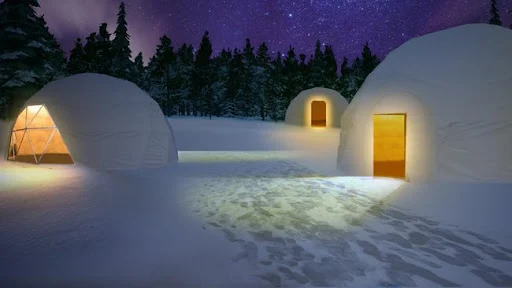Made from snow, how come igloo houses don't make Eskimos shiver?
Photo: Special
Jakarta - You've probably heard of Igloos, Eskimo houses made of snow? Have you ever thought about how Eskimos lived in that house? Aren't you cold?
According to Science ABC, Thursday (21/9/2023), the igloo house is made from blocks of snow that have hardened and become dense. This hardened snow is an excellent insulator.
This is because, basically, snow is semi-frozen water with about 95% trapped air. Air pockets in the snow prevent heat loss due to convection.
SCROLL TO CONTINUE WITH CONTENT
Quoting detikEdu, Thursday (21/9/2023), convection is heat transfer that occurs due to the movement of molecules that carry heat. In the process, heat transfer moves from molecules with a higher density to molecules with a lower density.
So, how do igloo houses keep Eskimos warm?
The way an igloo works is the same as a blanket. When we are under a blanket, we will feel warm. In fact, blankets do not produce that warm temperature. Blankets only prevent our body heat loss.
Likewise with igloo houses. The warm temperature inside an igloo house actually comes from the occupant's own body heat. When inside an igloo, Eskimos' body heat moves around the walls through convection. Then, this heat warms some of the air inside the igloo house.
Cool air stays at the bottom of the igloo, while warm air rises toward the top of the structure. This is because cold air has a higher density than hot air. The principles of this knowledge were then used by the Eskimos to build the interior structure of the igloo house.
The warmer upper structure of the igloo house is used as a bed. Meanwhile, the central structure is used as a cooking area and fireplace. The lower structure functions as a source of cold and a place to store food.
So, how warm is the igloo house?
If built correctly, the temperature inside an igloo house can be around 40℃ warmer than the outside environment. A study conducted by Rich Holihan and colleagues showed that the temperature near the body of a person inside an igloo can reach around 36℃. The temperature drops to around 16℃ in the air surrounding the person. Meanwhile, the temperature near the igloo walls can reach around 1℃.
A temperature of 16℃ or 1℃ is still quite comfortable for Eskimo people considering that temperatures in the Arctic region can reach -40℃ to -50℃. The more people there are in the igloo, the warmer the temperature inside.
Terbuat dari Salju, Kok Bisa Rumah Iglo Nggak Bikin Orang Eskimo Mengigil?
Foto: Istimewa
Jakarta - Kamu mungkin pernah mendengar tentang rumah Iglo, rumah orang Eskimo yang terbuat dari salju? Pernah nggak kepikiran bagaimana orang-orang Eskimo tinggal di rumah tersebut? Apa nggak kedinginan, ya?
Melansir Science ABC, Kamis (21/9/2023), rumah iglo terbuat dari blok-blok salju yang telah mengeras dan padat. Salju yang telah mengeras ini merupakan isolator yang sangat baik.
Hal ini karena, pada dasarnya, salju merupakan air yang semi-beku dengan sekitar 95% udara yang terperangkap. Kantong udara di dalam salju mencegah hilangnya panas akibat konveksi.
SCROLL TO CONTINUE WITH CONTENT
Mengutip detikEdu, Kamis (21/9/2023), konveksi merupakan perpindahan panas yang terjadi karena perpindahan molekul yang membawa panas. Dalam prosesnya, perpindahan panas bergerak dari molekul dengan massa jenis yang lebih tinggi ke molekul dengan massa jenis lebih rendah.
Lantas, bagaimana rumah iglo tetap membuat orang Eskimo merasa hangat?
Cara kerja rumah iglo sama seperti selimut. Ketika berada di bawah selimut, kita akan merasakan hangat. Faktanya, selimut tidak menghasilkan suhu hangat tersebut. Selimut hanya mencegah kehilangan panas tubuh kita.
Begitu pula dengan rumah iglo. Suhu hangat di dalam rumah iglo sebenarnya berasal dari panas tubuh penghuninya sendiri. Ketika berada di dalam rumah iglo, panas tubuh orang-orang Eskimo berpindah ke sekitar dinding-dindingnya melalui konveksi. Lalu, panas ini menghangatkan sebagian udara di dalam rumah iglo.
Udara dingin menetap di dasar iglo, sedangkan udara hangat naik menuju struktur bagian atas. Hal ini karena udara dingin memiliki massa jenis yang lebih tinggi daripada udara panas. Prinsip ilmu inilah yang kemudian digunakan orang-orang Eskimo dalam membangun struktur interior rumah iglo.
Struktur bagian atas rumah iglo yang lebih hangat digunakan sebagai tempat tidur. Sementara itu, struktur bagian tengah digunakan sebagai tempat memasak dan perapian. Struktur bagian bawah berfungsi sebagai sumber dingin dan tempat menyimpan makanan.
Lalu, seberapa hangat, sih, rumah iglo itu?
Jika dibangun dengan benar, suhu di dalam rumah iglo dapat berkisar 40℃ lebih hangat dibandingkan lingkungan luar. Sebuah studi yang dilakukan oleh Rich Holihan dan rekannya menunjukkan bahwa suhu di dekat tubuh orang di dalam iglo bisa mencapai sekitar 36℃. Suhu tersebut turun menjadi sekitar 16℃ di udara yang mengelilingi orang tersebut.
Sementara itu, suhu di dekat dinding iglo bisa mencapai sekitar 1℃.
Suhu 16℃ atau 1℃ masih terbilang cukup nyaman bagi orang-orang Eskimo mengingat suhu di wilayah Kutub Utara bisa mencapai -40℃ hingga -50℃. Makin banyak orang di dalam rumah iglo, makin hangat suhu di dalamnya.

